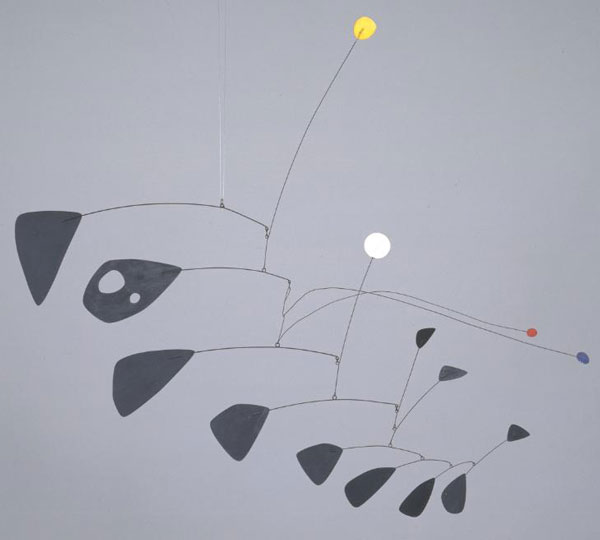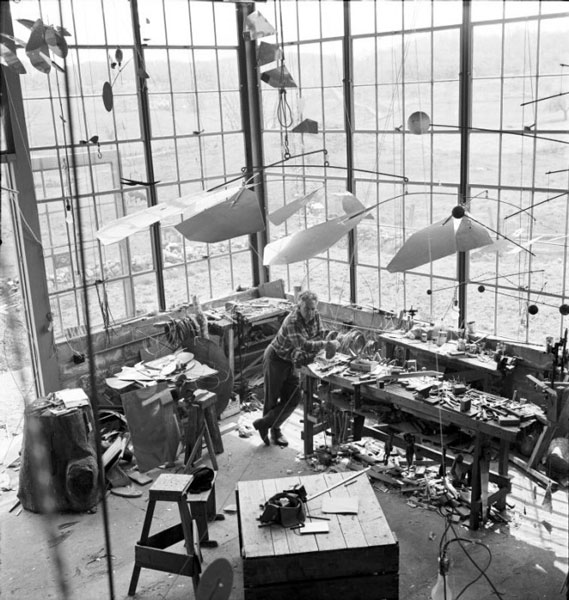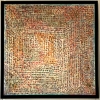Tate Modern
Bankside,
London SE1 9TG, United Kingdom
Call +44 (0)20 7887 8888
Tate London11 November 2015 – 3 April 2016
Tate Modern, Level 3
Supported by Terra Foundation for American Art with additional support from the Performing Sculpture Supporters Circle
Open daily from 10.00 – 18.00 and until 22.00 on Friday and Saturday
For public information call +44 (0)20 7887 8888, visit tate.org.uk, follow @Tate #CalderTate Modern presents the UK’s largest ever exhibition of Alexander Calder (1898-1976). Calder was one of the truly ground-breaking artists of the 20th century and, as a pioneer of kinetic sculpture, played an essential role in shaping the history of modernism. Alexander Calder: Performing Sculpture brings together approximately 100 works to reveal how Calder turned sculpture from a static object into a continually changing work to be experienced in real time.
Alexander Calder initially trained as an engineer before attending painting courses at the Arts Students League in New York. He travelled to Paris in the 1920s where he developed his wire sculptures and by 1931 had invented the mobile, a term first coined by Marcel Duchamp to describe Calder’s motorised objects. The exhibition traces the evolution of his distinct vocabulary – from his initial years captivating the artistic bohemia of inter-war Paris, to his later life spent between the towns of Roxbury in Connecticut and Sachéin France.
 |
| Alexander Calder Antennae with Red and Blue Dots c1953 Aluminium and steel wire © 2015 Calder Foundation, New York and DACS, London |
|
The exhibition also features the figurative wire portraits Calder created of other artists including Joan Miró 1930 and Fernand Léger c.1930, alongside depictions of characters related to the circus, the cabaret and other mass spectacles of popular entertainment, including Two Acrobats 1929, The Brass Family 1929 and Aztec Josephine Baker c.1929. Following a visit to the studio of Piet Mondrian in 1930,where he was impressed with the environment-as-installation, Calder created abstract, three-dimensional, kinetic forms and suspended vividly coloured shapes in front of panels or within frames hung on the wall. Red Panel 1936, White Panel 1936 and Snake and the Cross 1936 exemplify the artist’s continuous experimentation with forms in space and the potential for movement to inspire new sculptural possibilities. They are shown together with a selection of other panels and open frames for the first time, illustrating this important moment in Calder’s development. The exhibition includes a selection of his most significant motorised mobiles. Black Frame 1934 and A Universe 1934 reveal the ways in which Calder made use of his training as an engineer and his fascination with the dynamism of the cosmos. By 1932, Calder’s suspended sculptures would begin to move without motors, animated by just the lightest of air currents. In Snow Flurry I 1948, Calder demonstrates his masterful expertise in constructing large-scale mobiles whose equilibrium and reduced palette awards them their sublime quality. Calder reinvented the possibilities of sculpture in parallel with avant-garde developments in theatre and dance. He incorporated elements of choreography and sound to fundamentally change the principles of traditional sculpture, creating mobiles which chime and resonate such as Red Gongs 1950, Streetcar 1951 and Triple Gong 1951. The exhibition closes with Calder’s large scale mobile Black Widow c.1948, shown for the first time ever outside Brazil,demonstrating how his art in motion turned global after WWII and came to serve as a visual metaphor for a new and free social order. Alexander Calder: Performing Sculpture is curated by Achim Borchardt-Hume, Director of Exhibitions; Ann Coxon, Curator; and Vassilis Oikonomopoulos, Assistant Curator; and is organised in close collaboration with the Calder Foundation. |
 |
| Alexander Calder in his Roxbury studio, 1941 Photo credit: Calder Foundation, New York / Art Resource, NY © 2015 Calder Foundation, New York / DACS, London |
|
American sculptor Alexander Calder was a radical figure who pioneered kinetic sculpture, bringing movement to static objects. Calder travelled to Paris in the 1920s, having originally trained as an engineer, and by 1931 he had invented the mobile, a term coined by Duchamp to describe Calder’s sculptures which moved of their own accord. His dynamic works brought to life the avant-garde’s fascination with movement, and brought sculpture into the fourth dimension. Continuing Tate Modern’s acclaimed reassessments of key figures in modernism, Alexander Calder: Performing Sculpture will reveal how motion, performance and theatricality underpinned his practice. It will bring together major works from museums around the world, as well as showcasing his collaborative projects in the fields of film, theatre, music and dance. |
|
Related events Curator’s tour and private view Tate Modern, Level 3 Monday 14 December 2015, 18.30 – 20.30 £20, concessions available
Earle Brown’s Calder Piece 1963-66 and Alexander Calder’s Chef d’orchestre 1966 Tate Modern, Turbine Hall Tuesday 10 November 2015, 18.30 – 20.00 £18, concessions available
Mi Gran Obra (My Great Work) Tate Modern Thursday 14 January 2016 – Sunday 17 January 2016, please check website for times £18, concessions available Recommended for ages 12 and overMi Gran Obra (My Great Work) is what David Espinosa would do if he had an unlimited budget, a huge theatre, 300 actors, a military band, a rock group, animals, cars and helicopters. The Catalan actor, director and puppeteer has adapted this ambition into a performance for a stage no bigger than a small table; a colossal spectacle in miniature. These performances are part of the London International Mime Festival 2016, which promotes and champions contemporary visual theatre from around the world. |
























